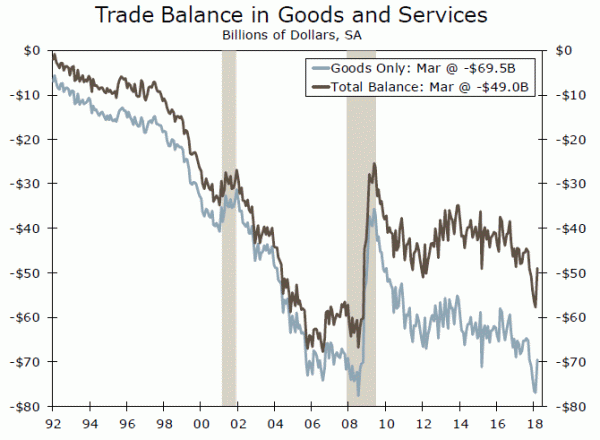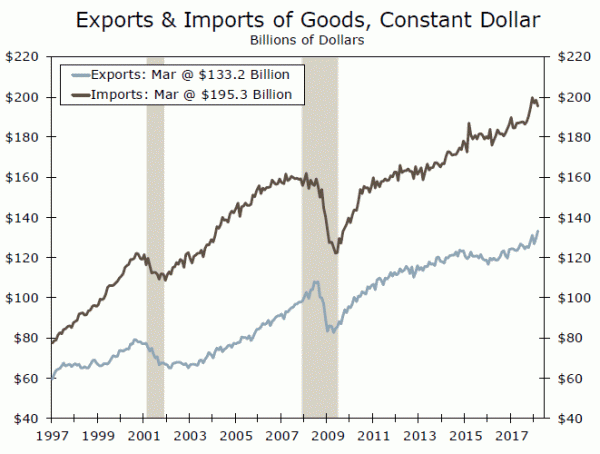One off factors—a jump in aircraft exports and the timing of the Chinese New Year—likely played a factor in the marked decline in the trade deficit in March.
Sharp Decline in Trade Deficit Probably Fleeting
The U.S. trade deficit narrowed sharply in March, falling from a 9-year high of $57.7 billion in February to $49.0 billion (top chart). Preliminary data released last week indicated that the red ink in the trade account had declined significantly in March, so the outturn was not much of a surprise to market participants. A $4.2 billion jump in exports of goods and services in tandem with the $4.6 billion drop in imports led to the sizeable drop in the trade deficit.
The jump in exports was generally broad based, but it was led by the $1.9 billion rise in exports of aircraft. Due to the “lumpy” nature of aircraft, this export component is notoriously volatile on a monthly basis, so we would not read too much into the rise in aircraft exports in March. Although petroleum products account for less than 10 percent of total U.S. exports, their share is growing due to the rebound in oil prices over the past two years and the increase in the nation’s oil production to more than 10 million barrels per day (middle chart).
There were broad-based declines on the import side of the ledger, with industrial supplies and materials down more than $700 million, capital goods off $1.5 billion and consumer goods $928 million lower. Weakness in imports can often signal softness in domestic demand, but recently-released GDP data show that growth in U.S. domestic demand was reasonably solid in the first quarter. Rather, the sharp drop in imports in March may reflect, at least in part, the timing of Chinese New Year, when Chinese ports close. In that regard, imports of toys, games and sporting equipment were off roughly $700 million in March, as were imports of televisions and video equipment. The combined imports of computer accessories and telecommunications equipment fell more than $1 billion. Moreover, import growth was very strong in February, so some payback is to be expected.
The GDP data that were released last week showed that real net exports boosted overall GDP growth by 0.2 percentage points in Q1. Furthermore, real exports of goods rose 2.0 percent in February and by an additional 2.9 percent in March (bottom chart). Even if there is some retrenchment in real exports in April, they probably will grow at a solid rate in Q2. On the other hand, the sizeable decline in real imports—they fell 1.6 percent in March—means that import growth likely will be muted in the second quarter. In short, real net exports likely will not exert much drag on overall GDP growth in Q2, and they could even provide a modest boost depending on the dynamics in the next few months. Looking further ahead, economic growth in America’s trading partners should continue to provide a boost to exports, while solid growth in U.S. domestic demand should continue to pull in imports. We forecast that real net exports will be broadly neutral to overall U.S. real GDP growth.
















